Question Bank midterm-1 PDF

| Title | Question Bank midterm-1 |
|---|---|
| Course | Cell Biology |
| Institution | University of Ontario Institute of Technology |
| Pages | 47 |
| File Size | 1.1 MB |
| File Type | |
| Total Downloads | 15 |
| Total Views | 169 |
Summary
Test Bank for Midterm 1 (Approximately 1.5 months into course)...
Description
ESSENTIAL CELL BIOLOGY, FOURTH EDITION CHAPTER 1: CELLS: THE FUNDAMENTAL UNITS OF LIFE © 2014 GARLAND SCIENCE PUBLISHING
Unity and Diversity of Cells 1-1
Living systems are incredibly diverse in size, shape, environment, and behavior. It is estimated that there are between 10 million and 100 million different species. Despite this wide variety of organisms, it remains difficult to define what it means to say something is alive. Which of the following can be described as the smallest living unit? (a) DNA (b) cell (c) organelle (d) protein
1-5
The flow of genetic information is controlled by a series of biochemical reactions that result in the production of proteins, each with its own specific order of amino acids. Choose the correct series of biochemical reactions from the options presented here. (a) replication, transcription, translation (b) replication, translation, transcription (c) translation, transcription, replication (d) translation, replication, transcription
1-6
Proteins are important architectural and catalytic components within the cell, helping to determine its chemistry, its shape, and its ability to respond to changes in the environment. Remarkably, all of the different proteins in a cell are made from the same 20 __________. By linking them in different sequences, the cell can make protein molecules with different conformations and surface chemistries, and therefore different functions. (a) nucleotides. (b) sugars. (c) amino acids. (d) fatty acids.
1-7
Which statement is NOT true about mutations? (a) A mutation is a change in the DNA that can generate offspring less fit for survival than their parents. (b) A mutation can be a result of imperfect DNA duplication. (c) A mutation is a result of sexual reproduction. (d) A mutation is a change in the DNA that can generate offspring that are as fit for survival as their parents are.
1-8
Changes in DNA sequence from one generation to the next may result in offspring that are altered in fitness compared with their parents. The process of change and selection over the course of many generations is the basis of __________. Page 1 of 47
(a) (b) (c) (d)
mutation. evolution. heredity. reproduction.
The Prokaryotic Cell 1-17
By definition, prokaryotic cells do not possess __________. (a) a nucleus. (b) replication machinery. (c) ribosomes. (d) membrane bilayers.
1-18
Although there are many distinct prokaryotic species, most have a small range of shapes, sizes, and growth rates. Which of the following characteristics are not observed in prokaryotes? (a) a highly structured cytoplasm (b) endoplasmic reticulum (c) the ability to divide rapidly (d) a cell wall
1-20
Prokaryotic cells are able to evolve very fast, which helps them to rapidly adapt to new food sources and develop resistance to antibiotics. Which of the options below lists the three main characteristics that support the rapid evolution of prokaryotic populations? (a) microscopic, motile, anaerobic (b) aerobic, motile, rapid growth (c) no organelles, cell wall, can exchange DNA (d) large population, rapid growth, can exchange DNA
1-25
The __________ __________ is made up of two concentric membranes and is continuous with the membrane of the endoplasmic reticulum. (a) plasma membrane (b) Golgi network (c) mitochondrial membrane (d) nuclear envelope
1-26
The nucleus, an organelle found in eukaryotic cells, confines the __________, keeping them separated from other components of the cell. (a) lysosomes (b) chromosomes (c) peroxisomes Page 2 of 47
(d)
ribosomes
1-27
Which of the following organelles has both an outer and an inner membrane? (a) endoplasmic reticulum (b) mitochondrion (c) lysosome (d) peroxisome
1-28
Mitochondria perform cellular respiration, a process that uses oxygen, generates carbon dioxide, and produces chemical energy for the cell. Which answer below indicates a correct pairing of material “burned” and the form of energy produced during cellular respiration? (a) fat, ADP (b) sugar, fat (c) sugar, ATP (d) fat, protein
1-30
Mitochondria contain their own genome, are able to duplicate, and actually divide on a different time line from the rest of the cell. Nevertheless, mitochondria cannot function for long when isolated from the cell because they are __________________. (a) viruses. (b) parasites. (c) endosymbionts. (d) anaerobes.
1-31
The mitochondrial proteins found in the inner membrane are involved in the conversion of ADP to ATP, a source of energy for the cell. This process consumes which of the following substances? (a) oxygen (b) nitrogen (c) sulfur (d) carbon dioxide
1-33
Chloroplasts are found only in eukaryotic cells that carry out photosynthesis: plants and algae. Plants and algae appear green as a result of the presence of chlorophyll. Where is chlorophyll located in the chloroplast? (a) in the first, outer membrane (b) in the space between the first and second membranes (c) in the second, inner membrane (d) in the third, innermost membrane
1-34
Photosynthesis enables plants to capture the energy from sunlight. In this essential process, plants incorporate the carbon from CO2 into high-energy __________ molecules, which the plant cell mitochondria use to produce ATP. (a) fat Page 3 of 47
(b) (c) (d)
sugar protein fiber
1-37
Which of the following choices best describes the role of the lysosome? (a) transport of material to the Golgi (b) clean-up, recycling, and disposal of macromolecules (c) sorting of transport vesicles (d) the storage of excess macromolecules
1-39
The cell constantly exchanges materials by bringing nutrients in from the external environment and shuttling unwanted by-products back out. Which term describes the process by which external materials are captured inside vesicles and brought into the cell? (a) degradation (b) exocytosis (c) phagocytosis (d) endocytosis
1-40
Eukaryotic cells are able to trigger the release of material from secretory vesicles to the extracellular space using a process called exocytosis. An example of materials commonly released this way is _____________. (a) hormones. (b) nucleic acids. (c) sugars. (d) cytosolic proteins.
1-41
__________ are fairly small organelles that provide a safe place within the cell to carry out certain biochemical reactions that generate harmful, highly reactive oxygen species. These chemicals are both generated and broken down in the same location. (a) Nucleosomes (b) Lysosomes (c) Peroxisomes (d) Endosomes
1-42
The cytoskeleton provides support, structure, motility, and organization, and it forms tracks to direct organelle and vesicle transport. Which of the cytoskeletal elements listed below is the thickest? (a) actin filaments (b) microtubules (c) intermediate filaments (d) none of the above (all the same thickness)
Page 4 of 47
1-43
Despite the differences between eukaryotic and prokaryotic cells, prokaryotes have proteins that are distantly related to eukaryotic actin filaments and microtubules. What is likely to be the most ancient function of the cytoskeleton? (a) cell motility (b) vesicle transport (c) membrane support (d) cell division
1-44
Which of the following characteristics would not support the idea that the ancestral eukaryote was a predator cell that captured and consumed other cells? (a) dynamic cytoskeleton (b) large cell size (c) ability to move (d) rigid membrane
1-47
Which pair of values best fills in the blanks in this statement: On average, eukaryotic cells are __________ times longer and have _________ times more volume than prokaryotic cells. (a) 5, 100 (b) 10, 200 (c) 10, 100 (d) 10, 1000
ESSENTIAL CELL BIOLOGY, FOURTH EDITION CHAPTER 4: PROTEIN STRUCTURE AND FUNCTION © 2014 GARLAND SCIENCE PUBLISHING
The Shape and Structure of Proteins 4-3
Polypeptides are synthesized from amino acid building blocks. The condensation reaction between the growing polypeptide chain and the next amino acid to be added involves the loss of ________________. (a) a water molecule. (b) an amino group. (c) a carbon atom.(d) a carboxylic acid group.
4-4
The variations in the physical characteristics between different proteins are influenced by the overall amino acid compositions, but even more important is the unique amino acid ______________. (a) number. (b) sequence. (c) bond. Page 5 of 47
(d)
orientation.
4-8
Fully folded proteins typically have polar side chains on their surfaces, where electrostatic attractions and hydrogen bonds can form between the polar group on the amino acid and the polar molecules in the solvent. In contrast, some proteins have a polar side chain in their hydrophobic interior. Which of the following would not occur to help accommodate an internal, polar side chain? (a) A hydrogen bond forms between two polar side chains. (b) A hydrogen bond forms between a polar side chain and the protein backbone. (c) A hydrogen bond forms between a polar side chain and an aromatic side chain. (d) Hydrogen bonds form between polar side chains and a buried water molecule.
4-9
To study how proteins fold, scientists must be able to purify the protein of interest, use solvents to denature the folded protein, and observe the process of refolding at successive time points. What is the effect of the solvents used in the denaturation process? (a) The solvents break all covalent interactions. (b) The solvents break all noncovalent interactions. (c) The solvents break some of the noncovalent interactions, resulting in a misfolded protein. (d) The solvents create a new protein conformation.
4-10
Which of the fol lowing statements is true? (a) Peptide bonds are the only covalent bonds that can link together two amino acids in proteins. (b) The polypeptide backbone is free to rotate about each peptide bond. (c) Nonpolar amino acids tend to be found in the interior of proteins. (d) The sequence of the atoms in the polypeptide backbone varies between different proteins.
4-14
Protein folding can be studied using a solution of purified protein and a denaturant (urea), a solvent that interferes with noncovalent interactions. Which of the following is observed after the denaturant is removed from the protein solution? (a) The polypeptide returns to its original conformation. (b) The polypeptide remains denatured. (c) The polypeptide forms solid aggregates and precipitates out of solution. (d) The polypeptide adopts a new, stable conformation.
4-15
The correct folding of proteins is necessary to maintain healthy cells and tissues. Unfolded proteins are responsible for such neurodegenerative disorders as Alzheimer’s disease, Huntington’s disease, and Creutzfeldt–Jakob disease (the specific faulty protein is different for each disease). What is the ultimate fate of these disease-causing, unfolded proteins? Page 6 of 47
(a) (b) (c) (d)
They are degraded. They bind a different target protein. They form structured filaments. They form protein aggregates.
4-16
Which of the following is not true of molecular chaperones? (a) They assist polypeptide folding by helping the folding process follow the most energetically favorable pathway. (b) They can isolate proteins from other components of the cells until folding is complete. (c) They can interact with unfolded polypeptides in a way that changes the final fold of the protein. (d) They help streamline the protein-folding process by making it a more efficient and reliable process inside the cell.
4-17
Molecular chaperones can work by creating an “isolation chamber.” What is the purpose of this chamber? (a) The chamber acts as a garbage disposal, degrading improperly folded proteins so that they do not interact with properly folded proteins. (b) This chamber is used to increase the local protein concentration, which will help speed up the folding process. (c) This chamber serves to transport unfolded proteins out of the cell. (d) This chamber serves to protect unfolded proteins from interacting with other proteins in the cytosol, until protein folding is completed.
4-19
The three-dimensional coordinates of atoms within a folded protein are determined experimentally. After researchers obtain a protein’s structural details, they can use different techniques to highlight particular aspects of the structure. What visual model best displays a protein’s secondary structures (α helices and β sheets)? (a) ribbon (b) space-filling (c) backbone (d) wire
4-21
Although all protein structures are unique, there are common structural building blocks that are referred to as regular secondary structures. Some proteins have α helices, some have β sheets, and still others have a combination of both. What makes it possible for proteins to have these common structural elements? (a) specific amino acid sequences (b) side-chain interactions (c) the hydrophobic-core interactions (d) hydrogen bonds along the protein backbone
4-22
Which of the following is not a feature commonly observed in α helices? (a) left-handedness (b) one helical turn every 3.6 amino acids Page 7 of 47
(c) (d)
cylindrical shape amino acid side chains that point outward
4-23
Which of the following is not a feature commonly observed in β sheets? (a) antiparallel regions (b) coiled-coil patterns (c) extended polypeptide backbone (d) parallel regions
4-24
Two or three α helices can sometimes wrap around each other to form coiled-coils. The stable wrapping of one helix around another is typically driven by ________________ interactions. (a) hydrophilic (b) hydrophobic (c) van der Waals (d) ionic
4-25
Coiled-coils are typically found in proteins that require an elongated structural framework. Which of the following proteins do you expect to have a coiled-coil domain? (a) insulin (b) collagen (c) myoglobin (d) porin
4-26
β Sheets can participate in the formation of amyloid fibers, which are insoluble protein aggregates. What drives the formation of amyloid fibers? (a) denaturation of proteins containing β sheets (b) extension of β sheets into much longer β strands (c) formation of biofilms by infectious bacteria (d) β-sheet stabilization of abnormally folded proteins
4-27
Protein structures have several different levels of organization. The primary structure of a protein is its amino acid sequence. The secondary and tertiary structures are more complicated. Consider the definitions below and select the one that best fits the term “protein domain.” (a) a small cluster of α helices and β sheets (b) the tertiary structure of a substrate-binding pocket (c) a complex of more than one polypeptide chain (d) a protein segment that folds independently
4-41
Globular proteins fold up into compact, spherical structures that have uneven surfaces. They tend to form multisubunit complexes, which also have a rounded shape. Fibrous proteins, in contrast, span relatively large distances within the cell and in the extracellular space. Which of the proteins below is not classified as a fibrous protein? (a) elastase Page 8 of 47
(b) (c) (d)
collagen keratin elastin
4-42
Which of the following globular proteins is used to form filaments as an intermediate step to assembly into hollow tubes? (a) tubulin (b) actin (c) keratin (d) collagen
4-43
You have two purified samples of protein Y: the wild-type (nonmutated) protein and a mutant version with a single amino acid substitution. When washed through the same gelfiltration column, mutant protein Y runs through the column more slowly than the normal protein. Which of the following changes in the mutant protein is most likely to explain this result? (a) the loss of a binding site on the mutant-protein surface through which protein Y normally forms dimers (b) a change that results in the mutant protein acquiring an overall positive instead of a negative charge (c) a change that results in the mutant protein being larger than the wild-type protein (d) a change that results in the mutant protein having a slightly different shape from the wild-type protein
4-44
Which of the following statements is true? (a) Disulfide bonds are formed by the cross-linking of methionine residues. (b) Disulfide bonds are formed mainly in proteins that are retained within the cytosol. (c) Disulfide bonds stabilize but do not change a protein’s final conformation. (d) Agents such as mercaptoethanol can break disulfide bonds through oxidation.
4-46
Proteins bind selectively to small-molecule targets called ligands. The selection of one ligand out of a mixture of possible ligands depends on the number of weak, noncovalent interactions in the protein’s ligand-binding site. Where is the binding site typically located in the protein structure? (a) on the surface of the protein (b) inside a cavity on the protein surface (c) buried in the interior of the protein (d) forms on the surface of the protein in the presence of ligand
4-47
Cyclic AMP (cAMP) is a small molecule that associates with its binding site with a high degree of specificity. Which types of noncovalent interactions are the most important for providing the “hand in a glove” binding of cAMP? (a) hydrogen bonds (b) electrostatic interactions (c) van der Waals interactions (d) hydrophobic interactions Page 9 of 47
4-52
Lysozyme is an enzyme that specifically recognizes bacterial polysaccharides, which renders it an effective antibacterial agent. Into what classification of enzymes does lysozyme fall? (a) isomerase (b) protease (c) nuclease (d) hydrolase
4-53
Which of the following mechanisms best describes the manner in which lysozyme lowers the energy required for its substrate to reach its transition-state conformation? (a) by binding two molecules and orienting them in a way that favors a reaction between them (b) by altering the shape of the substrate to mimic the conformation of the transition state (c) by speeding up the rate at which water molecules collide with the substrate (d) by binding irreversibly to the substrate so that it cannot dissociate
4-54
Studies conducted with a lysozyme mutant that contains an AspAsn change at position 52 and a GluGln change at position 35 exhibited almost a complete loss in enzymatic activity. What is the most likely explanation for the decrease in enzyme activity in the mutant? (a) increased affinity for substrate (b) absence of negative charges in the active site (c) change in the active-site scaffold (d) larger amino acids in the active site decreases the affinity for substrate
4-60
The biosynthetic pathway for the two amino acids E and H is shown schematically in Figure Q4-60. You are able to show that E inhibits enzyme V, and H inhibits enzyme X. Enzyme T is most likely to be subject to feedback inhibition by __________________ alone.
Figure Q4-60 (a) (b) (c) (d)
H B C E
Page 10 of 47
4-61
Which of the following statements about allostery is true? (a) Allosteric regulators are often products of other chemical reactions in the same biochemical pathway. (b) Allosteric regulation is always used for negative regulation of enzyme ...
Similar Free PDFs

Dmdw-question bank - question bank
- 17 Pages

Question bank
- 8 Pages
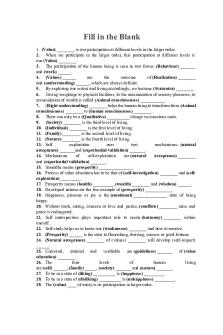
Question Bank 3question bank
- 6 Pages

Question BANK
- 19 Pages
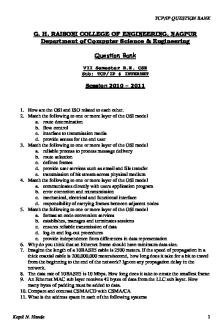
Tcp-ip-question-bank
- 25 Pages

Chapter 4 - Question Bank
- 28 Pages

DIP Question Bank Sheetal
- 14 Pages
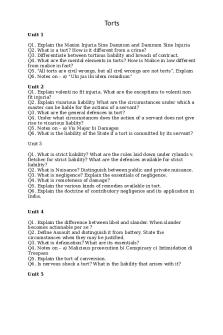
Torts Question Bank
- 2 Pages
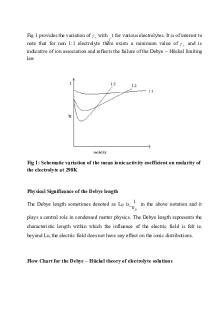
QB5 - Question Bank 5
- 104 Pages

Assessment Question Bank 1
- 22 Pages
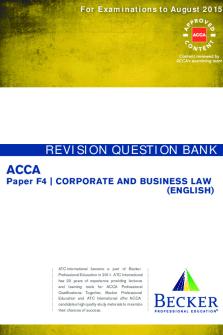
Revision Question Bank 60
- 154 Pages
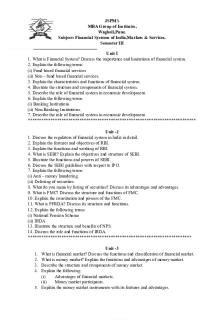
Fsims Question Bank
- 4 Pages

11. Autocad question bank
- 14 Pages
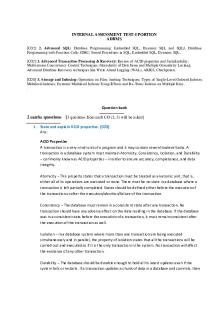
Question bank Adbms - solution
- 45 Pages

Viva Question Bank - CSS
- 17 Pages

Strategic Management Question Bank
- 29 Pages
Popular Institutions
- Tinajero National High School - Annex
- Politeknik Caltex Riau
- Yokohama City University
- SGT University
- University of Al-Qadisiyah
- Divine Word College of Vigan
- Techniek College Rotterdam
- Universidade de Santiago
- Universiti Teknologi MARA Cawangan Johor Kampus Pasir Gudang
- Poltekkes Kemenkes Yogyakarta
- Baguio City National High School
- Colegio san marcos
- preparatoria uno
- Centro de Bachillerato Tecnológico Industrial y de Servicios No. 107
- Dalian Maritime University
- Quang Trung Secondary School
- Colegio Tecnológico en Informática
- Corporación Regional de Educación Superior
- Grupo CEDVA
- Dar Al Uloom University
- Centro de Estudios Preuniversitarios de la Universidad Nacional de Ingeniería
- 上智大学
- Aakash International School, Nuna Majara
- San Felipe Neri Catholic School
- Kang Chiao International School - New Taipei City
- Misamis Occidental National High School
- Institución Educativa Escuela Normal Juan Ladrilleros
- Kolehiyo ng Pantukan
- Batanes State College
- Instituto Continental
- Sekolah Menengah Kejuruan Kesehatan Kaltara (Tarakan)
- Colegio de La Inmaculada Concepcion - Cebu